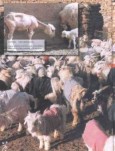"It is the most interesting book I have ever read and inspires me to do something immediate to save our civilization." —Hanh Lien, translator for the Vietnamese edition of World on the Edge


After a few days, when yet another sandstorm has blown away the sand dune, this kind of manually extended pole will be left behind.


On February 8th, the Chinese government announced an emergency appropriation, increasing its agricultural budget by 25 percent, or roughly $3 billion. The additional funds primarily will be used to raise support prices for wheat and rice, the principal food staples, and to improve irrigation infrastructure. For the State Council to approve such an increase outside of the normal budget—making process indicates the government's mounting concern about food security.
After a remarkable expansion of grain output from 90 million tons in 1950 to 392 million tons in 1998, China's grain harvest has fallen in four of the last five years—dropping to 322 million tons in 2003. For perspective, this drop of 70 million tons exceeds the entire grain harvest of Canada.
Production of each of the three grains that dominate China's agriculture—wheat, rice, and corn—has dropped. But the output of wheat, grown mostly in the water-short north, has fallen the most. With wheat stocks falling and domestic prices climbing, Chinese wheat-buying delegations recently have visited several grain-exporting countries. Initial purchases of some 5 million tons in Australia, Canada, and the United States have already sent world wheat prices climbing.
The recent price rises may be only the early tremors before the quake, however. China's harvest shortfalls of recent years have been covered by drawing down its once massive stocks of grain. But these will soon be depleted, forcing the government to cover the shortfall with imports.
China's wheat harvest fell short of consumption last year by 19 million tons. When the country's wheat stocks are depleted within the next year or so, the entire shortfall will have to be covered from imports. In some ways, the rice deficit is even more serious. Trying to cover a rice shortfall of 20 million tons in a world where annual rice exports total only 26 million tons could create chaos in the world rice economy. And with a corn shortfall of 15 million tons and stocks already largely depleted, China may soon have to import corn as well.
The handwriting on the wall is clear. While grain production is dropping, demand is climbing, driven up by the addition of 11 million people per year and by fast-rising incomes. As people in China earn more, they are moving up the food chain, eating more grain-fed livestock products such as pork, poultry, eggs, and, to a lesser degree, beef and milk.
The fall in China's grain harvest is due largely to a shrinkage of the grain harvested area from 90 million hectares in 1998 to 76 million hectares in 2003. Several trends are converging to reduce the grain area, including the loss of irrigation water, desert expansion, the conversion of cropland to nonfarm uses, the shift to higher-value crops, and a decline in double-cropping due to the loss of farm labor in the more prosperous coastal provinces.
Water tables are falling throughout the northern half of China. As aquifers are depleted and irrigation wells go dry, farmers either revert to low-yield dryland farming or, in the more arid regions, abandon farming altogether. In the competition for scarce water, China's cities and industry invariably get first claim, leaving farmers with a shrinking share of a shrinking supply. Losing irrigation water may mean either abandoning land or less double cropping.
China's farmers are also losing land to expanding deserts, such as the Gobi, which is consuming an additional 4,000 square miles each year. Paying farmers in the north and west to plant their grainland to trees to halt these advancing deserts is further reducing the grain area.
Urban expansion, industrial construction, and highway construction are all shrinking the land available for crops. The enthusiasm for establishing development zones for commercial and residential building or industrial parks in the hope of attracting investment and jobs is taking big chunks of cropland. The Ministry of Land and Resources reports that some 6,000 development zones and industrial parks cover some 3.5 million hectares.
Cars, too, are taking a toll. Every 20 cars added to China's automobile fleet require the paving of an estimated 0.4 hectares of land (1 acre—roughly the area of a football field) for parking lots, streets, and highways. Thus the 2 million new cars sold in 2003 meant paving over an area equal to 100,000 football fields.
In a country where farms average 1.6 acres (0.6 hectares), many grain farmers are shifting to higher-value fruits and vegetables to boost income. In each of the last 11 years, the area in fruits and vegetables has increased, expanding by an average of 1.3 million hectares a year.
In the more prosperous coastal provinces, the migration of farm labor to cities has made it more difficult to double-crop land. For example, the once widespread practice of planting winter wheat and summer corn depends on quickly harvesting the wheat when it ripens in June and immediately preparing the seedbed to plant the corn. Many villages no longer have enough able-bodied workers to make this quick transition—and the double-cropped area is shrinking as a result.
Reversing the fall in grain production will not be easy even with China's newly adopted economic incentives. Each trend that is shrinking the grainland area has a great deal of momentum. Reversing any one of them would take an enormous effort. Reversing all of them is inconceivable. If the new economic incentives should coincide with unusually favorable weather this year, a modest upturn in grain production might result, but it will likely be only temporary.
China is the first major grain-producing country where environmental and economic trends have combined to reverse the historical growth in grain production. This decline in the grain harvest in a country that is home to more than one fifth of the world's people will affect all of us.
Barring an economic collapse, China soon will be forced to turn to the world market for massive imports of 30, 40, or 50 million tons per year. This comes at a time when world grain stocks are at their lowest level in 30 years and when U.S. farmers are losing irrigation water to aquifer depletion and to cities. Among other things, this means that the surplus world grain production capacity and cheap food of the last half-century may soon be history. Higher food prices could become a permanent part of the economic landscape. Adjusting to these higher food prices could become a dominant preoccupation of governments in the years ahead.
When China turns to the world market, it will necessarily turn to the United States, which controls nearly half of world grain exports. This presents an unprecedented geopolitical situation in which 1.3 billion Chinese consumers who have a $120-billion trade surplus with the United States—enough to buy the entire U.S. grain harvest twice over—will compete with Americans for U.S. food, likely driving up food prices for the United States and the world.
Moving grain from the United States to China on the scale that is needed will likely involve loading two or three ships every day. The long line of grain-laden ships that may soon stretch across the Pacific will bring these two countries closer together economically, but managing the flow of grain to optimize the benefits for people in both countries will not be easy. It could become one of the major U.S. foreign policy challenges of this new century.
Copyright © 2004 Earth Policy Institute


 Print:
Print:  Email
Email